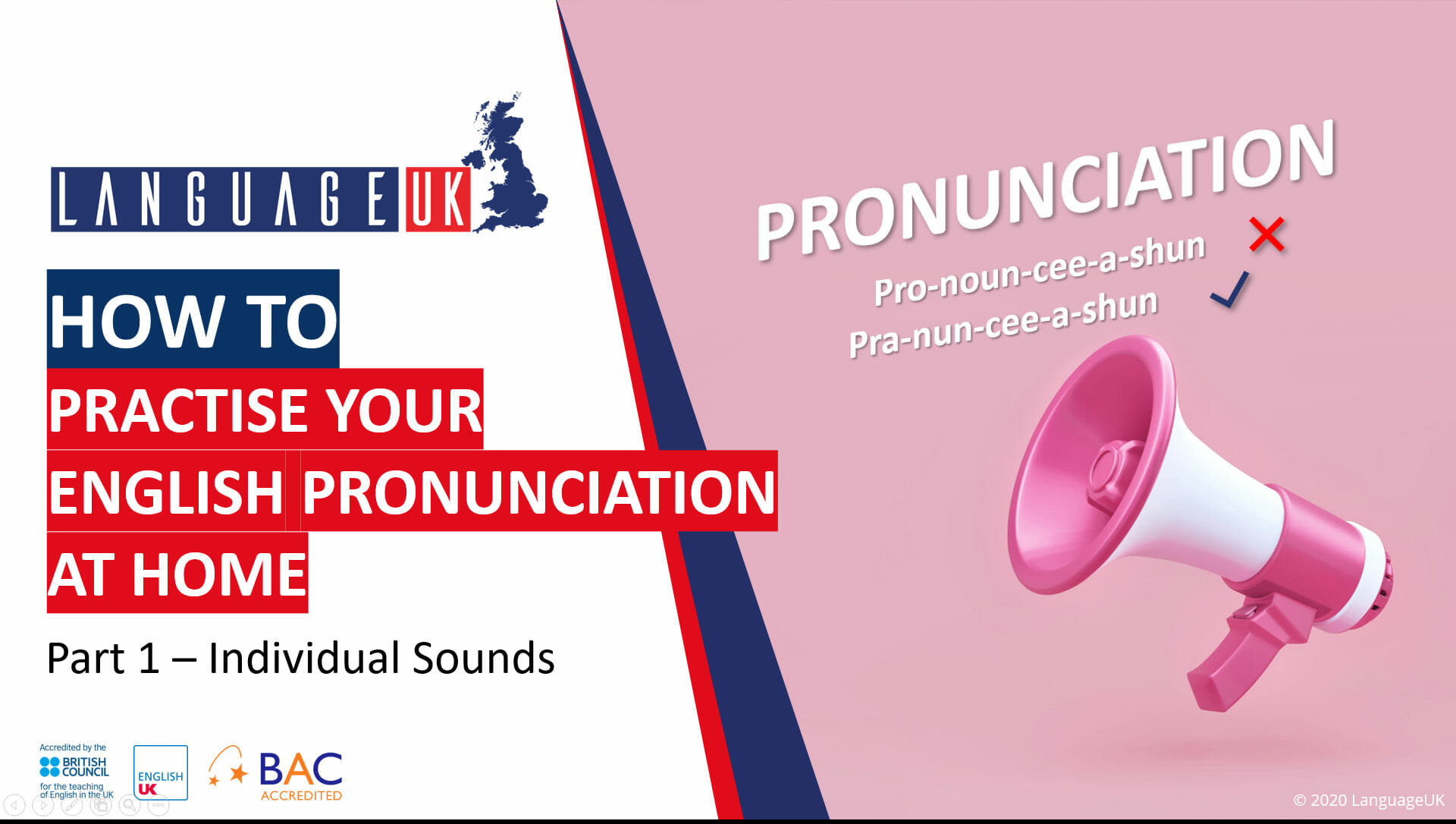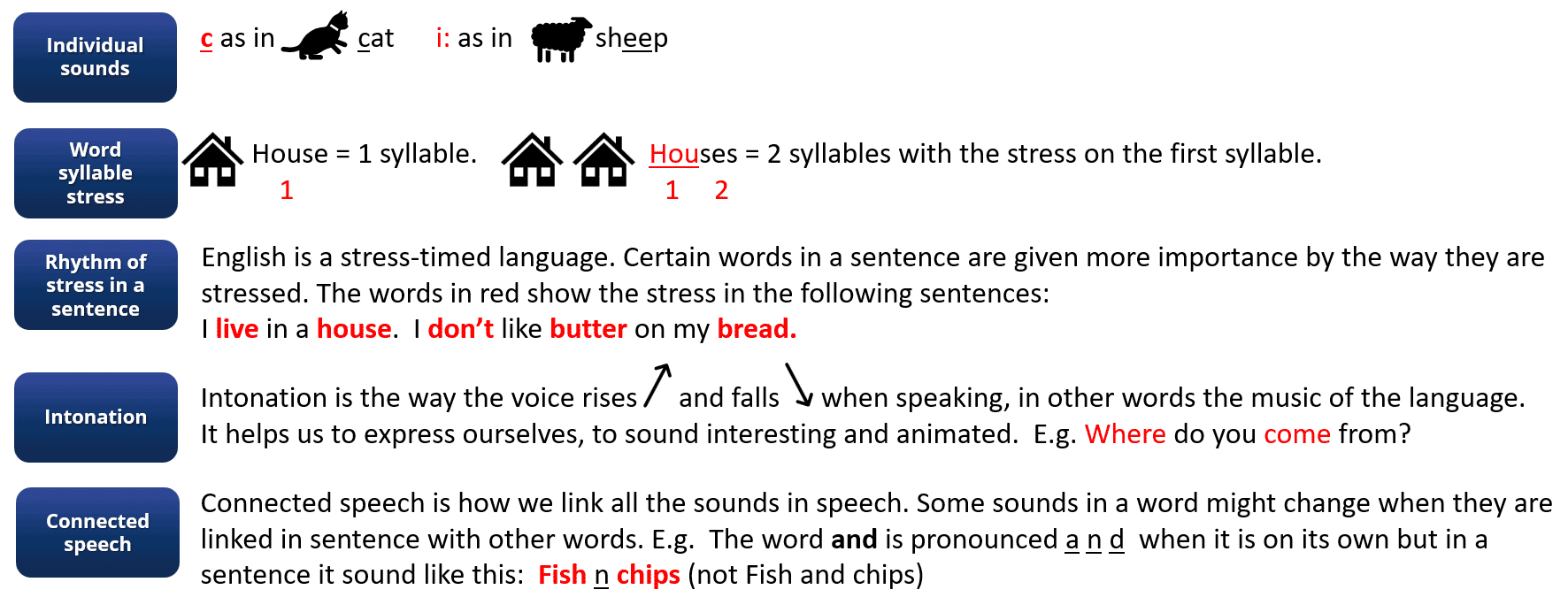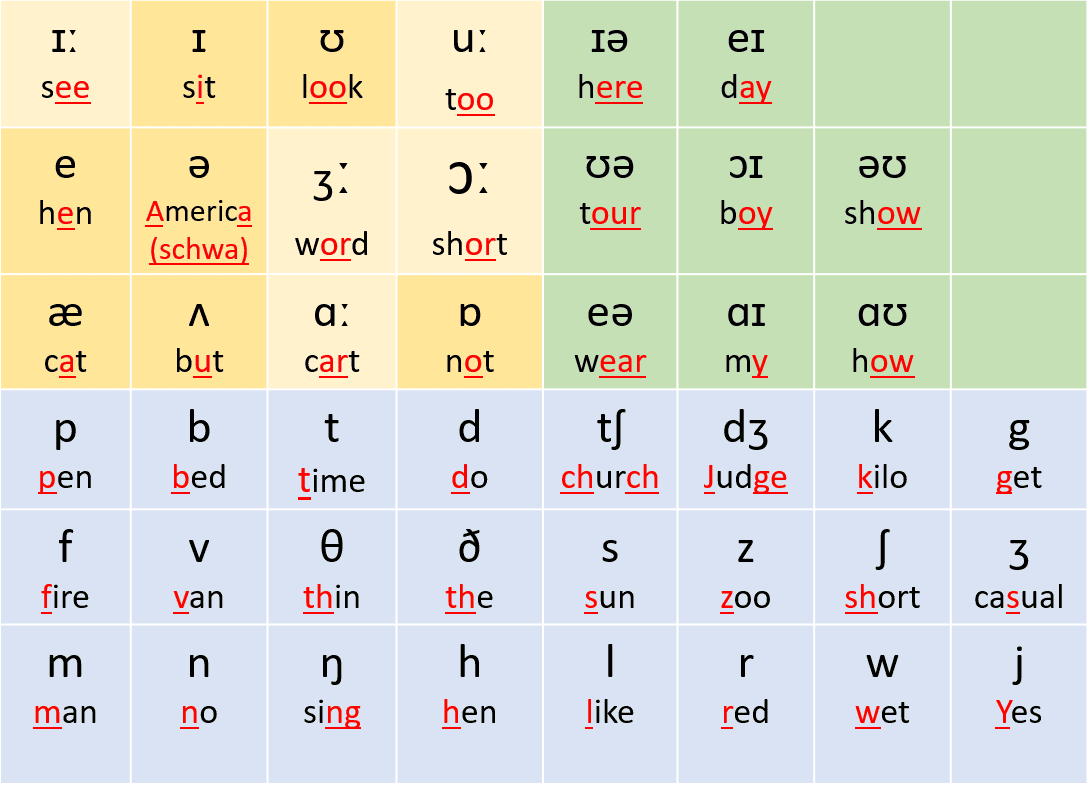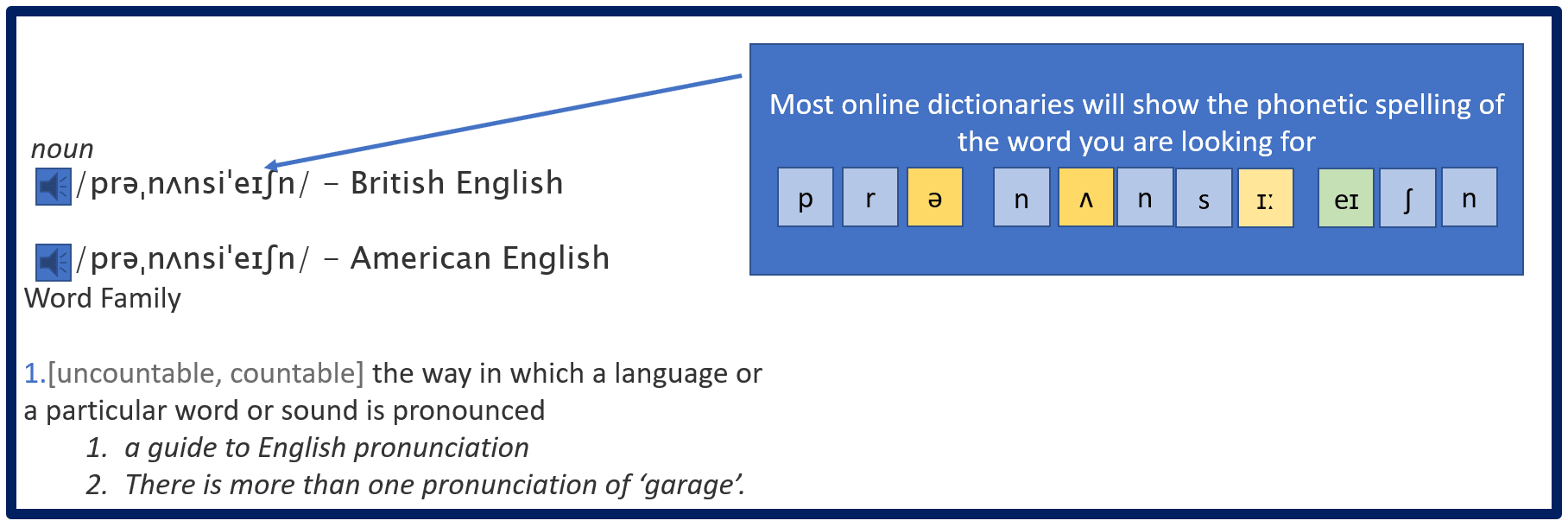INDIVIDUAL SOUNDS
The English alphabet which we use to write has 26 letters but (British English) has 44 SOUNDS!
THE PHONEMIC ALPHABET – the 44 sounds (phonemes)
Listen to the sounds and words for each sound. The sound is underlined and in red for each word.
The table is colour coded and separated into sections:
How to recognise the sounds in a dictionary
Do I need to learn all the 44 individual sounds?
The answer to this question is NO
It is good to be aware and to know how the sound system works and to recognise this when you check a word using an online dictionary. A typical dictionary entry might look like this:
Click onto the following link to listen: Oxford learners dictionary pronunciation
Practice – Using the online dictionary
Write down 3 favourite words, search for the word using the link below and paste the phonetic spelling
Tip 1: Don’t forget to look at the phonetic spelling when you check the online dictionary and listen to the recorded pronunciation
Practice: Minimal Pairs – Vowel sounds
Minimal pairs are two words that have the same pronunciation except for just one different sound
For example: Spelling Sounds
Cat /kæt/
Cart /kɑːt/
The vowel sounds in the 2 words are different. Cat has a short vowel sound. Cart has a long vowel sound
Remember! Long vowel sounds are written with ː as in uː ʒː ɔː ɑː ɪː
1. Listen to the recording and select the word you hear – complete the questions and see how you score
Practice – Using the online dictionary
Consonant sounds fit into patterns and some are voiced and some are voiceless. Consonants are articulated using different parts of the mouth, tongue and teeth and we use words to describe this. We have tried to simplify this below to show you how to recognise the differences and similarities and show how the sounds fit into separate categories
To start, let’s explain the following:
A Voiced sound = a deep sound that makes your vocal cords vibrate
Practise: Put your fingers on your throat (larynx) and say the following sounds and words:
A Voiceless sound = a sound that does not vibrate. It is softer
Practise: Say the following sounds and words:
Voiced and voiceless consonant pairs
Practise saying some of the voiced and voiceless consonant pairs.
1.bad pad
2. do to
3. good could
4. van fan
5. zoo sue
6. breath breathe
7. pleasure pressure
8. joke choke
Practise saying the following sentences using the voiced and voiceless consonant pairs.
1. To bake the bread perfectly, place the bread promptly above in the baker’s oven.
2. Turn down the dark tunnel taking time to drive down to the town.
3. The good kind cook gave the cakes to the greedy kids.
4. A very fanatical fan followed the vain footballer to victory.
5. Zebras with soft stripes can be seen in a zoo.
6. I thought and thought of thanking the thoughtful man.
7. The fashion publisher came to the conclusion that they needed to publish more pictures.
8. Jill jumped joyfully and chatted cheerfully to John.
Consonant Clusters
A consonant cluster is when 2 consonants are positioned together in a word. They can appear at the beginning of a word or at the end of a word or both. In most words each consonant is pronounced but sometimes the sounds can be reduced (not so strong) or dropped (not pronounced).
Examples of consonant clusters at the beginning of a word – /pl/ – please /sm/ – small /gr/ – great
Examples of consonant clusters at the end of a word – /mp/ – jump /nt/ – sent /pt/ – kept
Examples of consonant clusters at the end and the beginning of a word – /gr/ & /nd/ – ground /tr/ & / ŋk/ – trunk
Practise: Listen and practise saying the following:
Consonant clusters at the beginning of a word:
1. /sp/ spell speak spoon
2. /bl/ black blow blog
3. /kl/ clown close clock
4. /br/ brown brick bright
5. /kr/ crab cream create
6. /sl/ slow slim slick
7. /sn/ snake snow snap
8. /st/ star stamp stop
9. /pr/ prop prom pretty
10. /sm/ small smell smooth
Consonant clusters at the end of a word:
1. /st/ last first test
2. /sk/ mask desk risk
3. /ld/ cold fold told
4. /nd/ send pond find
5. / ŋk/ think tank thank
6. /lk/ milk silk bulk
7. /mp/ jump camp bump
8. /sp/ gasp crisp clasp
9. /ft/ left lift soft
10. / ʃ h/ wish cash rush
Tips on how to practise at home
In this guide we have looked at the individual sounds of English
1. Always check the pronunciation of a new word or a word you are not sure about by using an online dictionary. A good online dictionary which will give you the audio and phonetic spelling: oxford learners dictionary
2. 1, 2 or 3 words a day. Buy a small notebook. Choose a sound you want to practise and find 1, 2 or 3 words with the same sound using the online dictionary. Check the pronunciation of the word (s) and write the word (s) down in your notebook. You can choose to write the phonetic script next to the word if you wish. Listen and repeat as many times as you wish
3. Use the audio recordings in this guide to listen and repeat what you hear as many times as you wish. If you would like copies of the MP4 recordings, please let us know. Write to us and we can email the recordings: contact us
4. Use your phone or computer to record yourself:
i) Using the words and sentences in this guide
ii) Listening online to a native speaker, dictate or copy the script (keep it short – 1 or 2 sentences) repeat and record.
iii) Simply record yourself for 30 seconds a day and listen back to see how you sound
5. Listen, listen and listen! The more you listen to English, the better your pronunciation will be. There are thousands of online possibilities here. We recommend listening to short recordings, podcasts, vlogs and so on a regular basis.
BBC sounds is a very good app and free to use.
6. Contact us to book a lesson if you need some help practising the sounds of English: contact us
Did you enjoy this lesson taken from our Free English Study Guide?
Sign up to receive further lessons directly to your inbox.























